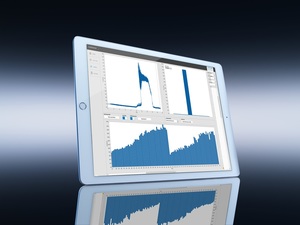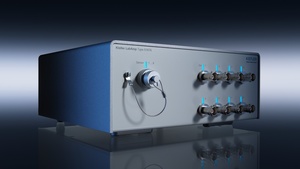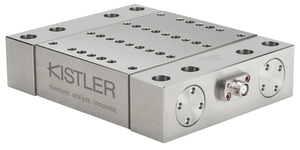
 |
Charlotte Stonestreet
Managing Editor |
| Home> | MACHINE BUILDING & ENGINEERING | >CAD/CAE | >Making machining research more efficient |
| Home> | MACHINE BUILDING & ENGINEERING | >Software | >Making machining research more efficient |
Editor's Pick
Making machining research more efficient
13 January 2025
Buelent Tasdelen reports on how Chalmers University of Technology is using new software from Kistler to advance metal cutting research

SUCCESSFUL ADVANCES in the development of machining methods, cutting tools and processes depend on two factors: state-of-the-art instruments and technology on the one hand, and highly trained researchers on the other. Both these requirements are excellently met at Chalmers University of Technology in Gothenburg, one of Sweden’s leading research centres.
This institution’s origins date back to 1829, when Swedish merchant William Chalmers left a legacy to establish a ‘technical school’ that has since become one of Europe’s most respected universities of technology, with over 11,000 students and almost 3,000 teaching and research staff at its two Gothenburg campuses. Chalmers is home to many R&D facilities including the International Grinding Centre (IGC), where academic research and industry collaborate on developing new technologies and skills to optimise grinding applications.
Peter Krajnik is the founder of the IGC, Professor of Manufacturing Technology at Chalmers, and a Member of the International Academy for Production Engineering (CIRP). Krajnik and his team play a key part in the IGC’s work by developing and optimising the efficiency of R&D tools and processes. He says: “High-quality research is inconceivable without high-level skills as well as high-caliber research tools. Research into metal cutting applications requires particularly extensive testing, analysis and reporting. Large numbers of test cycles are essential to achieve a high degree of consistency, and to enable publications of high quality.”
New software offers functions to automate research processes
As a member of the IGC, the Kistler Group plays its part by contributing innovative measurement technology that delivers high levels of performance and efficiency. One example is the world’s first – and thus far only – wireless piezoelectric RCD (rotating cutting dynamometer). Another Kistler innovation that was tested recently by the IGC is the new PTS (Piezo Tool System) app. This software can be used with all sensor systems connected to the high-end DAQ solutions in Kistler’s LabAmp series. Key features of the new app include automatic signal preconditioning (filters, drift compensation, feature detection, signal cuts, and more), automatic time- and frequency-based analysis (e.g. FFT and power spectrum), automatic value- and feature-based analysis and trend generation, flexible acquisition of raw and analysed data at different stages, machine communication via PTS Light Box and future monitoring functionality for industrial verification and manufacturing.
The IGC recently trialled the new PTS app in a wear testing application for grinding wheels at Chalmers. Krajnik again: “As well as automating the data acquisition (DAQ) process, the new PTS software platform from Kistler also automates analysis and reporting – even in real time, as proven during our metal cutting tests. So, it really does help us to be more efficient in our machining research.”
Force and frequency analysis – with just a few clicks
Wear testing of grinding wheels requires a deep understanding of the forces involved. Key parameters include the force levels, the static and dynamic components, and the ratios between different forces. Dr Philipp Hoier, Project Leader for this project at the IGC, explains: “In grinding applications, it’s important to measure and analyse not only the static values such as maximum and average, but also the ratios between forces, the dynamic components of the forces, and certain frequencies. Thanks to the new PTS software, we can perform a variety of analyses with just a couple of clicks.”
The measurement technology setup used during testing at the IGC consists of a complete measuring chain from Kistler: a stationary dynamometer, a LabAmp 5167A (a laboratory charge amplifier with integrated DAQ and Ethernet connection), an inductive switch to start and stop measurements automatically, and the new PTS software. This state-of-the-art setup made it easy to perform the grinding wheel lifecycle tests with a high degree of efficiency – and, given the number of repetitions needed, this added up to hours or even days of saved time for the researchers.
The PTS software comes with various types of pre-processing tools which researchers can use at different levels during DAQ and analysis. Once the settings are completed, the program will automatically take the raw data and perform the analysis with the chosen tools in the desired order for all the tests. The PTS app can cut the signals at different time intervals according to choice, perform advanced calculations (such as FFT and power spectrum), and apply different filters. Researchers can also choose an evaluation criterion – such as the maximum force in a specific direction – to generate trends that can be visualized and then evaluated automatically.
Live calculations and automated reporting
As the grinding wheel becomes worn, the levels of certain frequencies will increase – and the PTS software can automatically capture these increases. Since the tests focused on 340Hz, this frequency was monitored continuously. A trend analysis for this frequency can be generated directly during the test, and the PTS software can even calculate and visualise the FFT and power spectrum areas for each cut.
All the results, including both raw and analysed data, can be exported in different file formats. Reports as well as further analyses can be generated very easily: subsequent evaluation of the ratio between the normal force Fn and the feed force Ff for all tests is just one example. Kistler also offers an optional hardware component – the PTS Light Box – to trigger machine actions when defined events or alarms occur, so the machining process is stopped immediately in such cases.
Hoier sums up: “Thanks to the PTS app, we’re able to automate the DAQ as well as the analysis and reporting processes. When we’re busy operating the machine and the measurement equipment, this saves us researchers considerable time that we can then use for other important tasks. So we’re looking forward to using this new software not only for grinding, but also for other machining applications here at Chalmers such as turning, drilling or milling.”
Buelent Tasdelen is business development manager at Kistler
- EPLAN PLATFORM 2.1 IS RELEASED
- MODELLING EXPERTISE
- Free 3D CAD Models
- SWITCH TO THE POWER OF CAE
- Mobile Maintenance Solution For Automation Users
- Turbine Technology Development
- Efficiently drive your electrical projects with SEE Electrical V7R1
- Free To Download Software
- Monitor Multiple Devices On Single HMI Dashboard
- SEE Electrical






















